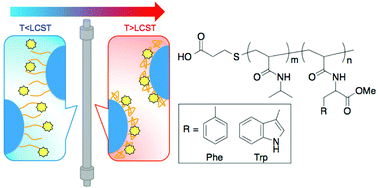Temperature-responsive molecular recognition chromatography using phenylalanine and tryptophan derived polymer modified silica beads†
Abstract
Temperature-responsive polymers incorporating molecular-recognition sites were developed as stationary phases for high-performance liquid chromatography (HPLC). The grafted stationary phases consisted of functional copolymers composed of N-isopropylacrylamide (NIPAAm) and N-acryloyl aromatic amino acid methyl esters, i.e., phenylalanine and tryptophan methyl esters (Phe-OMe and Trp-OMe). Three novel temperature-responsive polymers, P(NIPAAm-co-Phe-OMe5), P(NIPAAm-co-Phe-OMe10), and P(NIPAAm-co-Trp-OMe5), were synthesized. These copolymers exhibited a reversible hydrophilic/hydrophobic phase transition at their lower critical solution temperatures (LCSTs). The polymers were grafted onto aminopropyl silica using an activated ester-amine coupling method, and were packed into a stainless steel column, which was connected to an HPLC system. Temperature-responsive chromatography was conducted using water as the sole mobile phase. More hydrophobic analytes were retained longer, and the retention times of aromatic steroids and aromatic amino acids were dramatically increased. This indicated that π–π interactions occurred between the phenyl or indole moieties of phenylalanine or tryptophan, respectively, and the aromatic compounds. Furthermore, the retention times of compounds with hydrogen bond acceptors were higher with P(NIPAAm-co-Trp-OMe5), which contained indole as a hydrogen bond donor, than with P(NIPAAm-co-Phe-OMe5). This indicated that hydrogen bonding occurred between the stationary phase and the analytes. These results indicate that hydrophobic, π–π, and hydrogen bonding interactions all affected the separation mode of the temperature-responsive chromatography, and led to selective separation with molecular recognition. Both temperature-response and molecular recognition characteristics are present in the proposed separation system that utilizes a temperature-responsive polymer bearing aromatic amino acid derivatives.

- This article is part of the themed collection: Analyst Recent Open Access Articles

 Please wait while we load your content...
Please wait while we load your content...